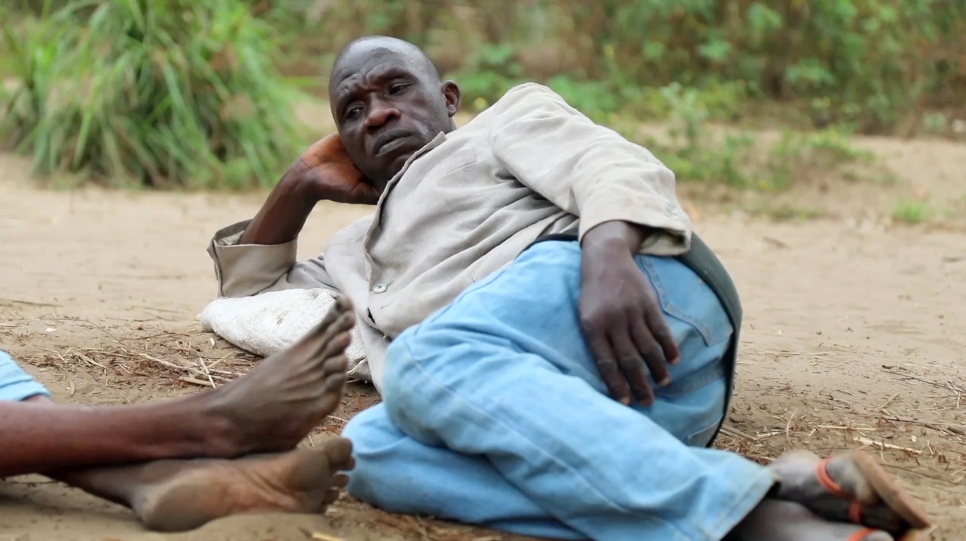Violence engulfs Congo's once-peaceful Kasaï region
A father is among more than 1.3 million people from the Democratic Republic of the Congo's Kasaï region fleeing a war that they never expected.

Internally displaced Congolese father Bernard, 25, sits on the floor of a former clinic in the town of Idiofa, Kwilu Province, with his sons. © UNHCR/John Wessels
IDIOFA, Democratic Republic of the Congo – Twenty-five-year-old Bernard* is a strong and healthy father of three. He does not seem like the type to be easily thrown off course by life. But right now, he is at a complete loss.
“The children keep asking me, daddy, where is mama? They think of her a lot and cry,” he says. “I sometimes take my mobile phone and pretend to call her and then I tell them that she will be coming soon. But this does not calm them anymore.”
For Bernard, one fateful day in April changed his life. He was in his office in the Kasaï region of the Democratic Republic of the Congo, or DRC, scheduling the year’s final exams for the school where he worked as an administrator.
“I suddenly heard people crying out and running.” He learnt that one of the militia groups which had sprung up in the area, was launching an attack nearby.
Shocked, he took off towards home. “When I got to my street, I saw that my house was in flames,” he says. “Everything was lost, everything was completely burnt.”
He puts his arms around his two boys, Raoul, two and Ramazani, five. “I found my boys standing alone, crying and afraid.” As he ran off with them, he saw his wife down the street. She had been brutally murdered by militia fighters, dozens of whom were nearby.
He could not find his seven-year-old daughter, Ngalula, and does not know what has become of her.
He now sits stoically on a wooden bench outside a former clinic in Idiofa, a town in central Kwilu Province, about 500 kilometers east of the capital, Kinshasa.
As his boys run around and play nearby, he recalls how different life was three months ago. “We had a really good life. I received my pay at the end of the month.” The family house had "four rooms, a roof with 53 iron sheets and a TV".
“We had never heard a gunshot in our lives.”
Now, they are among more than 1.3 million people that have become internally displaced by a conflict that has in recent months ravaged Kasaï, a vast area almost the size of Germany in the heart of DRC.
The Kasaï region has been known for stability that allowed its residents to live peaceful lives. All that changed last year when militia violence, followed by an army crackdown, pitched the area into chaos.
It began in August when a traditional chief, Jean-Pierre Mpandi -- better known by the tribal name “Kamuina Nsapu” -- was killed in a clash with the Congolese authorities. By early 2017, the conflict had spread to several provinces, with many militia groups springing up, most of them claiming to fight the government.
Bernard, like many others, is experiencing conflict for the first time. “We had never heard a gunshot in our lives,” he says.
He and others from the town escaped into the thick forest, so dense that “even at noon you thought it was night”. The group avoided the main roads due to militia presence. But with hardly any food or drinking water, some died during the two-week march to safety.
Along the way they occasionally found support from villagers, who provided shelter and what little food they could. Bernard remains grateful for this unexpected assistance even as he struggles to understand why they were attacked. “We don’t know what this war’s objective is. We have become victims of things we don’t know.”
A few kilometers away, Francois, a man in his fifties, leads a group of 10 men and a woman carrying a baby as they enter Idiofa. Like Bernard, they have walked for weeks through the forest.
“Back home, I was a teacher,” says Francois. He explains that he lost his wife and his two children. The group continues to the clinic where Bernard is also staying.
"When I got to my street, I saw that my house was in flames. Everything was lost.”
About 100 people arrive in Idiofa daily, often on foot, while many more stream into nearby towns in the province. Currently, there are 350 displaced people staying at the clinic with as many as 50 sleeping in a room, on the bare floor.
UNHCR, the UN Refugee Agency, is working with a local NGO, the Association for Social Development and Safeguarding of the Environment, to provide hot meals and water to the new arrivals. This support has encouraged over 3,000 displaced people sheltered by local families, in churches and in mosques, to come forward to be included in beneficiary lists.
“The process is important as it helps us identify vulnerable people like unaccompanied children who need special support,” says Ann Encontre, UNHCR’s representative for Central Africa.
“We are working with local partners to support the displaced, while we focus on protecting the most vulnerable people,” she adds.
Bernard and his family are grateful to be alive, but the pain of losing his young daughter continues to haunt him. “I loved her so much, but I do not know how I can see my daughter again,” he says. “Maybe she fled with a woman who has a good heart.”
*Name changed for protection reasons




